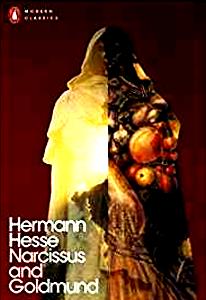The Meaning of Life
Hermann Hesse's sensitively crafted novels, with their abiding focus on man's
quest for identity and spiritual fulfilment, continue to have a powerful
resonance and are perhaps more pertinent today than when they first came
into print more than half a century ago. Among Hesse's novels,
Siddhartha
and
Journey to the East are the two that most strongly show the influence
of Buddhism, but the search for nirvana is a recurrent theme throughout much
of his work, perhaps most poignantly in
Narcissus and Goldmund.
First published in 1930, this utterly beguiling novel was the crowning achievement
of Hesse's literary career, a deceptively simple fable set in the Middle
Ages in which two contrasting individuals follow different paths towards
personal fulfilment.
One of these men, the slightly older Narcissus, is content to lead the ascetic
life of a monk-teacher in a monastery, dividing his time between his devotional
duties and the pupils whose education and personal development he is charged
with. Among the latter is a handsome and gifted teenage boy, Goldmund,
who idolises Narcissus and appears ready to follow in his footsteps - until
he has a dalliance with a gypsy girl which draws him towards a different
path, one that is strewn with the scented petals and sharp thorns of sensual
experience. Whilst Narcissus stays within the confines of his monastery,
Goldmund goes out into the world and, living as a carefree spirit, has a
series of adventures that have a massively transformative effect upon him.
The pleasures of the flesh are eagerly indulged in, helped by Goldmund's
seemingly irresistible sexual magnetism, but the young man's fancies are
soon directed towards other, more fulfilling ends, when he discovers he has
a talent for carving. Through hard work and perseverance, Goldmund
becomes a master of his craft, but rather than accept the easy and privileged
life that is suddenly thrust upon him, he gives all this up and resumes his
former life as a penniless wayfarer, eking out a meagre existence in the
countryside.
When, finally, he returns to Narcissus at the monastery, after committing
violent murder and witnessing the horrors of the Black Death, Goldmund is
a completely changed man. He has seen and experienced everything that
the world can offer a man, but whilst he no longer wishes to live like his
old friend, he now appears content to pursue a life of seclusion, within
the monastic refuge. The question we are invited to ponder is: which
of the two men has led the better life? The answer, of course, is neither.
Each has found his own way to the truth of his existence, both have fulfilled
their divine purpose.
Leila Vennewitz's recent (1994) translation for Penguin Books brings a freshness
and an incredible sense of immediacy to this classic of German literature.
The fluidity of her prose, whilst retaining Hesse's very distinctive voice,
makes this a compelling modern fable that cannot fail to resonate with anyone
who reads it. There is a particular, almost cinematic, vividness to
the description of the plague-riddled landscape, and Goldmund's anguish as
multiple tragedies rain down upon him in the latter third of the book is
keenly felt - each blow more painful than its predecessor.
Narcissus
and Goldmund is the most accessible and rewarding of Hesse's novels,
a dazzlingly humanist work that both inspires and consoles us as we make
our own search for meaning in a world that seems to offer so much freedom
and so little real satisfaction.
© James Travers 2019
The above content is owned by the author and must not be copied.
